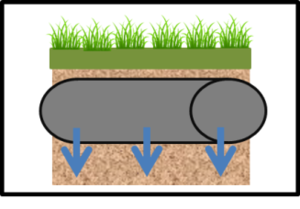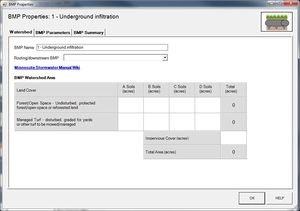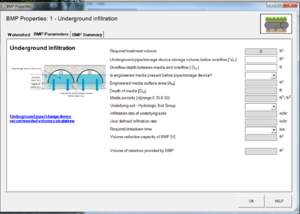
Difference between revisions of "Requirements, recommendations and information for using underground infiltration BMPs in the MIDS calculator"
| Line 27: | Line 27: | ||
**Underlying soil - Hydrologic Soil Group: The user selects the most restrictive soil (lowest hydraulic conductivity) within three feet of the soil/media interface in the infiltration basin. There are 14 soil options that fall into 4 different Hydrologic Soil Groups (Hydrologic Soil Group (HSG) A, B, C, or D) for the user. These correspond with soils and infiltration rates contained in this Manual. Once a soil type is selected, the corresponding infiltration rate will populate in the “Infiltration rate of underlying soils” field. The user may also select “User Defined.” This selection will activate the “User Defined Infiltration Rate” cell allowing the user to enter a different value from the values in the predefined selection list. The maximum allowable infiltration rate is 1.63 inches per hour. | **Underlying soil - Hydrologic Soil Group: The user selects the most restrictive soil (lowest hydraulic conductivity) within three feet of the soil/media interface in the infiltration basin. There are 14 soil options that fall into 4 different Hydrologic Soil Groups (Hydrologic Soil Group (HSG) A, B, C, or D) for the user. These correspond with soils and infiltration rates contained in this Manual. Once a soil type is selected, the corresponding infiltration rate will populate in the “Infiltration rate of underlying soils” field. The user may also select “User Defined.” This selection will activate the “User Defined Infiltration Rate” cell allowing the user to enter a different value from the values in the predefined selection list. The maximum allowable infiltration rate is 1.63 inches per hour. | ||
**'''Required drawdown time (hrs):''' This is the time in which the stormwater captured by the BMP must drain into the underlying soil/media. The user selects from predefined values of 48 or 24 hours. The MPCA Construction Stormwater General Permit requires drawdown within 48 hours, but 24 hours is Highly Recommended when discharges are to a trout stream. The calculator uses the underlying soil infiltration rate and the overflow depth to check if the BMP is meeting the drawdown time requirement. The user will encounter an error and be required to enter a new “Overflow depth” if the stormwwater stored in the BMP cannot drawdown in the required time. | **'''Required drawdown time (hrs):''' This is the time in which the stormwater captured by the BMP must drain into the underlying soil/media. The user selects from predefined values of 48 or 24 hours. The MPCA Construction Stormwater General Permit requires drawdown within 48 hours, but 24 hours is Highly Recommended when discharges are to a trout stream. The calculator uses the underlying soil infiltration rate and the overflow depth to check if the BMP is meeting the drawdown time requirement. The user will encounter an error and be required to enter a new “Overflow depth” if the stormwwater stored in the BMP cannot drawdown in the required time. | ||
| − | *'''BMP Summary Tab:''' The BMP Summary tab summarizes the volume and pollutant reductions provided by the specific BMP. It details the performance goal volume reductions and annual average volume, dissolved P, particulate P, and TSS load reductions. Included in the summary are the total volume and pollutant loads received by the BMP from its direct watershed, from upstream BMPs and a combined value of the two. Also included in the summary, are the volume and pollutant load reductions provided by the BMP, in addition to the volume and pollutant loads that exit the BMP through the outflow. This outflow load and volume is what is routed to | + | *'''BMP Summary Tab:''' The BMP Summary tab summarizes the volume and pollutant reductions provided by the specific BMP. It details the performance goal volume reductions and annual average volume, dissolved P, particulate P, and TSS load reductions. Included in the summary are the total volume and pollutant loads received by the BMP from its direct watershed, from upstream BMPs and a combined value of the two. Also included in the summary, are the volume and pollutant load reductions provided by the BMP, in addition to the volume and pollutant loads that exit the BMP through the outflow. This outflow load and volume is what is routed to the downstream BMP if one is defined in the Watershed tab. Finally, percent reductions are provided for the percent of the performance goal achieved, percent annual runoff volume retained, total percent annual particulate phosphorus reduction, total percent annual dissolved phosphorus reduction, total percent annual TP reduction, and total percent annual TSS reduction. |
| + | |||
| + | ===Model input requirements and recommendations=== | ||
| + | |||
| + | The following are requirements or recommendations for inputs into the MIDS calculator. If the following are not met, an error message will inform the user to change the input to meet the requirement. | ||
| + | *The water underneath the underdrain and in the engineered media must meet the drawdown time requirement specified. The drawdown time requirement is checked by comparing the user defined drawdown time with the calculated drawdown time(DDTcalc) calculated using the following: | ||
| + | |||
| + | <math> | ||
| + | 〖DDT〗_calc=(D_O+D_M)/(I_R/ 12) | ||
| + | </math> | ||
| + | |||
| + | :Where | ||
| + | ::D<sub>O</sub> is the depth between the underdrain and the engineered media(ft); | ||
| + | ::D<sub>M</sub> is the depth of the engineered media if present; and | ||
| + | ::I<sub>R</sub> is the infiltration rate of the native soils (inches/hr). | ||
| + | |||
| + | *Infiltration rates of the underlying soils are restricted to being below 1.63 inches per hour. | ||
| + | |||
| + | ===Methodology=== | ||
| + | |||
| + | ====Required Treatment Volume==== | ||
| + | |||
| + | “Required treatment volume,” or the volume of stormwater runoff delivered to the BMP, equals the performance goal (1.1 inches or user-specified performance goal) times the impervious area draining to the BMP, plus any water routed to the BMP from an upstream BMP. This stormwater is delivered to the BMP instantaneously following the Kerplunk method. | ||
| + | |||
| + | ====Volume Reduction==== | ||
| + | |||
| + | The volume reduction achieved by a BMP compares the capacity of the BMP to the required treatment volume. The “Volume reduction capacity of BMP” is calculated using BMP inputs provided by the user. For this BMP the volume reduction credit is equal to the amount of water that can be instantaneously captured by the BMP in the storage device and in the engineered media below the underdrain. The capture volume (V) is therefore equal to the following: | ||
| + | <math> | ||
| + | V= V_P+[A_M*n*D_M ] | ||
| + | </math> | ||
Revision as of 19:32, 29 June 2016
This page is in development and will contain guidance on using underground infiltration BMPs in the MIDS calculator
For an underground infiltration system, all stormwater captured in the underground pipe/storage device or in the underlying engineered media by the BMP is infiltrated into the underlying soil between rain events. All pollutants in the infiltrated water are credited as being reduced. Pollutants in the stormwater that bypasses the BMP are not reduced.
Contents
MIDS calculator user inputs for underground infiltration
For underground infiltration systems, the user must input the following parameters to calculate the volume and pollutant load reductions associated with the BMP.
- Watershed tab
- BMP Name: this cell is auto-filled but can be changed by the user.
- Routing/downstream BMP: if this BMP is part of a treatment train and water is being routed from this BMP to another BMP, the user selects the name of the BMP from the dropdown box to which water is being routed. All water must be routed to a single downstream BMP. The User must include the BMP receiving the routed water in the Schematic or the BMP will not appear in the dropdown box.
- BMP Watershed Area: BMP watershed areas are the areas draining directly to the BMP. Values can be added for four soil types (Hydrologic Soil Groups (HSG) A, B, C, D) and for three Land Cover types (Forest/Open Space, Managed Turf and impervious). The surface area of the BMP should be included as a managed turf land cover under the hydrologic soils group of the native soils located under the BMP. Units are in acres
- BMP Parameters tab
- Underground pipe/storage device storage volume below overflow (VP): The total storage volume in the pipe or storage device that is below the overflow. The storage device needs to be perforated to allow infiltration into the underlying soils. Methods for calculating the storage volume depend on the type of storage device used. Sample methods based on storage device can be found here. The user enters this value in cubic ft.
- Overflow depth between media and overflow (DO): The total depth between the outflow from the storage device to the underlying media. This value is used to calculate the drawdown time of the device to make sure it meets drawdown time requirements. The user enters this value in ft.
- Is engineered soil present below pipe/storage device?: The user enters ‘Yes’ if engineered soils designed to add storage capacity in increase infiltration are present below the storage device.
- Surface area of Engineered media (including pore spaces)(VM): The average surface area of the engineered media below the storage device. This value is used to calculate the volume of water that is stored in the engineered media. The user enters this value in square ft.
- Depth of media (DM): The depth of the engineered media below the storage device. This value is used to calculate the volume of water stored in the engineered soils. The user enters this value in ft.
- Media porosity (n): This is the ratio of pore space in the engineered media to the total volume of the engineered media. Units are volume/volume (e.g., cubic centimeters per cubic centimeter). If various types of media are used in the BMP, this value should be an average of the media installed between the underdrain and the native soils. Values for porosity based on soil type can be found here. Typical values range between 0.35 and 0.5 ft3/ft3.
- Underlying soil - Hydrologic Soil Group: The user selects the most restrictive soil (lowest hydraulic conductivity) within three feet of the soil/media interface in the infiltration basin. There are 14 soil options that fall into 4 different Hydrologic Soil Groups (Hydrologic Soil Group (HSG) A, B, C, or D) for the user. These correspond with soils and infiltration rates contained in this Manual. Once a soil type is selected, the corresponding infiltration rate will populate in the “Infiltration rate of underlying soils” field. The user may also select “User Defined.” This selection will activate the “User Defined Infiltration Rate” cell allowing the user to enter a different value from the values in the predefined selection list. The maximum allowable infiltration rate is 1.63 inches per hour.
- Required drawdown time (hrs): This is the time in which the stormwater captured by the BMP must drain into the underlying soil/media. The user selects from predefined values of 48 or 24 hours. The MPCA Construction Stormwater General Permit requires drawdown within 48 hours, but 24 hours is Highly Recommended when discharges are to a trout stream. The calculator uses the underlying soil infiltration rate and the overflow depth to check if the BMP is meeting the drawdown time requirement. The user will encounter an error and be required to enter a new “Overflow depth” if the stormwwater stored in the BMP cannot drawdown in the required time.
- BMP Summary Tab: The BMP Summary tab summarizes the volume and pollutant reductions provided by the specific BMP. It details the performance goal volume reductions and annual average volume, dissolved P, particulate P, and TSS load reductions. Included in the summary are the total volume and pollutant loads received by the BMP from its direct watershed, from upstream BMPs and a combined value of the two. Also included in the summary, are the volume and pollutant load reductions provided by the BMP, in addition to the volume and pollutant loads that exit the BMP through the outflow. This outflow load and volume is what is routed to the downstream BMP if one is defined in the Watershed tab. Finally, percent reductions are provided for the percent of the performance goal achieved, percent annual runoff volume retained, total percent annual particulate phosphorus reduction, total percent annual dissolved phosphorus reduction, total percent annual TP reduction, and total percent annual TSS reduction.
Model input requirements and recommendations
The following are requirements or recommendations for inputs into the MIDS calculator. If the following are not met, an error message will inform the user to change the input to meet the requirement.
- The water underneath the underdrain and in the engineered media must meet the drawdown time requirement specified. The drawdown time requirement is checked by comparing the user defined drawdown time with the calculated drawdown time(DDTcalc) calculated using the following\[ 〖DDT〗_calc=(D_O+D_M)/(I_R/ 12) \]
- Where
- DO is the depth between the underdrain and the engineered media(ft);
- DM is the depth of the engineered media if present; and
- IR is the infiltration rate of the native soils (inches/hr).
- Infiltration rates of the underlying soils are restricted to being below 1.63 inches per hour.
Methodology
Required Treatment Volume
“Required treatment volume,” or the volume of stormwater runoff delivered to the BMP, equals the performance goal (1.1 inches or user-specified performance goal) times the impervious area draining to the BMP, plus any water routed to the BMP from an upstream BMP. This stormwater is delivered to the BMP instantaneously following the Kerplunk method.
Volume Reduction
The volume reduction achieved by a BMP compares the capacity of the BMP to the required treatment volume. The “Volume reduction capacity of BMP” is calculated using BMP inputs provided by the user. For this BMP the volume reduction credit is equal to the amount of water that can be instantaneously captured by the BMP in the storage device and in the engineered media below the underdrain. The capture volume (V) is therefore equal to the following\[ V= V_P+[A_M*n*D_M ] \]


